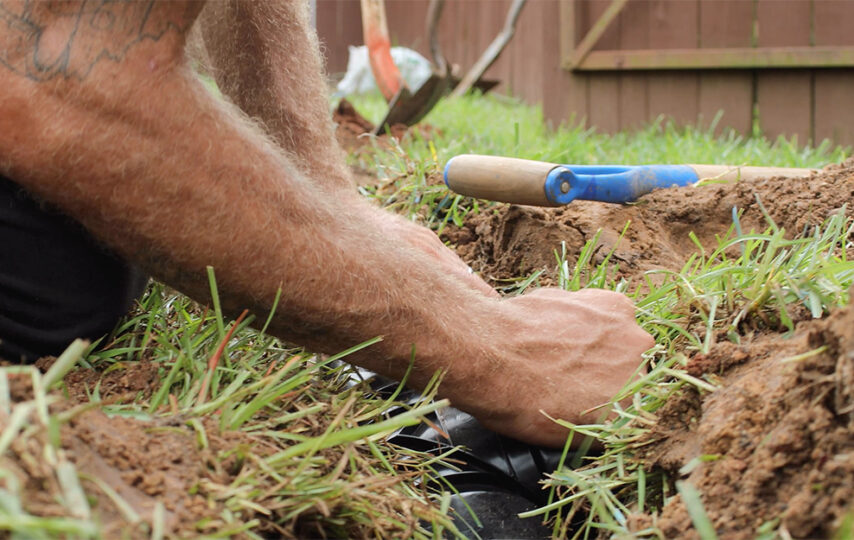Every part of your plumbing system has a purpose. The right combination of several working parts is what we call a plumbing system. One such essential part is the drains or the drainage system.
A building must effectively drain the water if it has to live long. Otherwise, the accumulated water can damage the building in many ways, such as seepage, plumbing blocks, or weakening of the foundation itself.
Thus, the storm water that entered your home—due to rain or storm—must be drained as immediately as possible. To do that, we have many types of drains at our disposal, as well as methods to quickly mitigate the damage.
Let’s take a look at them in this blog post!
1. Surface Drains
The first type of drain is the surface drainage system. It eliminates excess water that gathers on the land through ditches or channels. Sometimes you may grade or shape the ground to slop towards these channels.
Some surface drainage systems include open drains, grassed waterways, levees, and humps and loops. Cast-in-place trench drains are also perfect examples of surface drains.
2. Sub-Surface Drains
The next type of drainage system is the subsurface drain. These sit underneath the top layer of soil—one level below the surface drains.
These systems are commonly called French drains, which work at the root level to eliminate excess water from the surface. You need to dig ditches first to install the pipes of subsurface drains.
French drains aid in rerouting water from wherever the drain begins—typically near a building’s foundation—to a sewer or cistern.
French drains help the water’s natural flow from high to low. Thus, you see these drains in most residential locations divert water away from the buildings and gardens.
3. Slope Drains
A slope drainage systems drains water using a downward slope. Pipes that travel through the slope are used to help. The pipe is attached to an inclination, which directs water through it and quickly removes it from the structure.
4. Swale Drains
Swale drains are shallow ditches covered in turf grass or other vegetation. They are more subtle than conventional trench-style systems since they have a wider and shallower structure.
Swale drains serve to manage and slow down outdoor water runoff. They prevent flooding, puddles, and soil erosion caused by any water.
Besides, these drains also keep storm drains from being overloaded by a rapid surge of water by distributing water over a wider surface area and preventing runoff from draining too fast.
This landscaping technique is often used around both residential and business sites.
5. Point Drains
Due to the subterranean nature of this system, floors must slope toward the drain. These drains function similarly to the shower drain by collecting water from a central point or gully.
Point drains are frequently used where drainage is necessary from a particular point owing to structural or topographical requirements.
However, when you need several drains, the building may seem unattractive, thus, making it challenging to construct and set up.
6. HDPE Drains
A more recent development in drainage systems that has gained popularity is HDPE drains or High-density Polyethylene trench drains.
These systems have lightweight, pre-engineered modular channel parts that are simple to install. They have a silky feel and are quite strong. HDPE systems still need a grate covering, much like traditional trench drains.
The working of an HDPE drain is similar to a standard trench drainage system. They divert water from a surface area into a drain channel, sending it to a disposal facility, such as sewage.
These drains are a great choice for industrial applications due to their strong chemical resistance and general durability.
7. Trench Drains
Trench drains are a surface system. A trench drain consists of a sizable trench with a drain channel cemented in place. This channel is often covered by a thick metal grate and can be narrow or wide.
Trench drains function by preventing water from running off vast areas of ground. They draw the water from the ground’s surface and channel it through until it reaches the drainage point.
Commercial structures, such as restaurants and cargo docks, frequently have these systems installed nearby. You may also find them on city sidewalks and pool decks.
8. Cast-in-place Drains
This particular drainage system might be the most difficult to use out of all the others. To build, you must first dig a trench and place wood forms and a reinforcing bar. Then you fill the trench with concrete. This trench system requires a grate covering, much like the other trench systems.
These systems serve to keep floors dry and clean by diverting water and even trash from the floor surface into a channel and then via a catch system unless the channel becomes clogged.
These were widespread across many sectors at one time. But due to their cost and lacklustre performance, better options soon replaced them.
Final Say
These are the 8 types of drains you often notice in residential and commercial buildings. Keep these in mind when building your home’s plumbing system, as you have the right to decide what goes into your home and what doesn’t.
However, your plumber will suggest what is best for your home. A good plumber is essential for a healthy plumbing system. Plumbers of Mornington Jetting is one of the best you can find.
We hope you find the best drains for your home!







